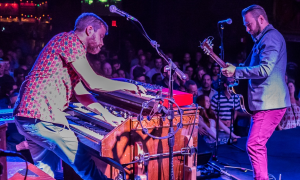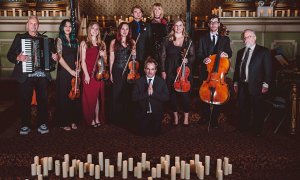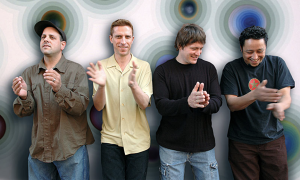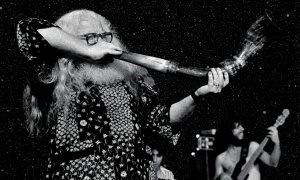Home » Jazz Articles » From the Inside Out » From Choro to Chaos
From Choro to Chaos
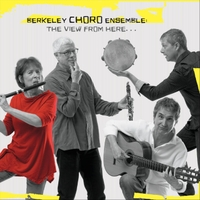 Berkeley Choro Ensemble
Berkeley Choro EnsembleThe View from Here
Self-Produced
2017
Like its organic natural wonders, the music of Brazil seems to flourish in different forms and styles of beauty. But much of its music has grown from the root of choro: Born in the mid-to late-1800s from the joining of Afro-Brazilian dance and jazz rhythms with European salon and chamber music, choro was simultaneously a seminal influence on Heitor Villa Lobos and other Brazilian classical composers, and in the fertile riverbed from which samba and bossa nova ultimately flowed.
The View from Here surveys choro from the perspective of the Berkeley Choro Ensemble, which flutist Jane Lenoir founded in 2010 to enhance "the performance of recent choro works and collaborations with renowned Brazilian performers and composers." Clarinetist Harvey Wainapel sings the Ensemble's other lead voice, complemented by guitarist (and Rio de Janiero native) Ricardo Peixoto and percussionist Brian Rice; Rice and Lenoir are co-founders and joint artistic directors of the Berkeley Festival of Choro.
Much of The View From Here underscores choro's emphasis on form as well as feeling. Written by celebrated producer, arranger, composer and pianist Cesar Camargo Mariano, "Choro #7" sounds so beautifully structured it suggests a Satie reverie, the sonic equivalent of a warm soft summer breeze full of rain and fragrance and hope and wonder. Wainapel's husky clarinet leads Lenoir's flute, floating and trailing like a kite, and the rest of the ensemble through "Do Mingus," while flute and clarinet play hide and seek with the melody to "Choro Manco," which sounds more baroque, formal and yet warm.
"Nesse Momento" delivers bigger and more complex sound via this same small instrumentation and volume. Guitarist Peixoto waves his classical acoustic sound in the direction of Spain rather than Brazil, more forceful strumming to accent the rhythm, with percussionist Rice gently pattering underfoot. Wainapel's clarinet solo is as light and beautiful as you can play that sometimes thorny instrument. It's easy to hear the chamber music aspects of this choro as its instrumental components organically grow and flow into each other like vines naturally climbing up a fencepost.
Made possible in part by a grant from the San Francisco Friends of Chamber Music Musical Grant Program, The View from Here is full of classic compositions, expertly and fondly played. In any country or language, that's beautiful music.
 Victor Assis Brasil
Victor Assis BrasilEsperanto-Toca Antonio Carlos Jobim
Far Out Recordings
2017
By the summer of 1970, popular music's lunatic joyride through the 1960s had fully careened into the new decade. Almost anything and everything still seemed possible. That summer, saxophonist Victor Assis Brasil returned to his home in Brazil from studies (alongside Dizzy Gillespie, Chick Corea, Ron Carter, and others) at the Berklee College of Music to record two albums for jazz producer Roberto Quartin's namesake label: A set of exploratory, deep jazz compositions titled Esperanto, and a warm, respectful tribute Toca Antonio Carlos Jobim. The same magnificent Brazilian jazz band—bassists Dom Salvador and Edson Lobo, drummer Edison Machado, and guitarist Helio Delmiro—supported the saxophonist through both albums (with an uncredited trumpeter blowing hot Brazilian bop in "Children," and an uncredited pianist diving into "Wave"), which Far Out's Quartin reissue series combined into this double-album, single-disc set.
The spirit of wide open musical horizons, with the freedom and courage to fully explore them, ripples throughout the freewheeling Esperanto. The band rips into Jimmy Heath's "Ginger Bread Boy" as its opener with a deliciously unbridled, almost primal, edge on its collective sound, especially Brasil's alto and Delmiro's frantically scratching guitar. They drive "Quarenta Graus A Sombra" into the far-out GrandMothers of Invention sound, a shapeshifting kaleidoscope of saxophone and guitar—one more explosion in the freedom revolution simultaneously erupting from recording studios around the world at this same time. In between, "Children" snuggles into production that feels more warm and soft, with cool electric keyboards giving shade to saxophone that sings like a child in sunlight.
"So Tinha De Ser Com Voce" opens Toca Antonio Carlos Jobim with this same warm but lively sound, as Brasil's saxophone languidly flows through its comfortable melody in an almost singing voice. Brasil and friends craft "Wave" into a brilliant ten-minute tribute worthy of its target, swirling strong saxophone and piano solos into a jazz whirlpool of reconstructed sound. Brasil adopts a mysterious, almost Egyptian sound on his alto in this skeletal arrangement of "Dindi,"with organ chords brooding over the guitarist's electric blues.
Esperanto-Toca Antonio Carlos Jobim is more than a snapshot of a time and place; more importantly, this snapshot captures its essential spirit.
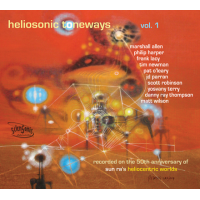 The Heliosonic Tone-tette
The Heliosonic Tone-tetteHeliosonic Toneways Vol. 1
ScienSonic Laboratories
2017
Many albums in the Sun Ra musical universe have a great backstory, but the story behind Heliosonic Toneways Vol. 1 is better than most.
On April 20 1965, Sun Ra recorded The Heliocentric Worlds of Sun Ra, featuring himself on the relatively obscure bass marimba, at Richard Alderson's RLA Studio in New York City. Ra recorded Heliocentric Worlds Vol. 2, featuring himself on tuned bongos and clavioline, soon thereafter.
Exactly fifty years from that day—April 20, 2015—ScienSonic Laboratories convened longtime Sun Ra Arkestra members Danny Ray Thompson and Marshall Allen (the only known surviving participant of that '65 Heliocentric session) to lead an ensemble tribute to "the distinctive instrumentation and sonic character of the original albums." Allen and Scott Robinson played the instruments that Ra handled on the original recordings (the bass marimba heard on Vol. 1 and the bongos and clavioline from Vol. 2), and Alderson returned to produce it.
Heliosonic Toneways Vol. 1 was improvised in the studio and is presented in the order in which it occurred. Nothing seems to connect one piece of music to another, but each piece contributes a distinct chapter to the outerspace epic told by the whole. "Heliotone 2A" shoots up from the electronic keyboard sound in which Ra rooted much of his solo music; bowed bass pulls out subsonic echoes of the bass marimba while electronics and contrapuntal horns paint abstract jazz colors in the sky. Called to order by various reeds and brass that flutter together like a flock of birds, "Heliotone 2B" coalesces into an Ellingtonian swing feeling led by the drummer's tap-dancing snare.
"Heliotone 3B" erupts (or deteriorates, depending) into an ensemble free-for-all that sounds like a marching band intersecting with the Duke Ellington Orchestra in a pool of psychedelic LSD. These same horns blast "Heliotone 7" skyward, leaving colorful rocket trails for the drums to dance in. Ushered in by acoustic piano and plaintive trombone, "Heliotone 4B" seems to at least start in New Orleans, but where it ends up as it floats away on no discernible tempo or meter seems like anybody's guess.
Heliosonic Toneways Vol. 1 lives up to the message printed on the back of those original 1965 album jackets: "You never heard such sounds in your life."
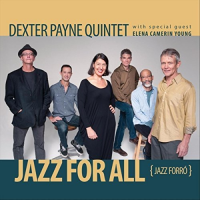 Dexter Payne
Dexter PayneJazz For All (Jazz Forró)
Dexofon Records
2018
Dexter Payne plays clarinet with an easy, warm and conversational style. It never sounds like he's pushing or stretching toward the next note, but more like he kind of just lets the next note flow out from this one. On Jazz For All, Payne and his quintet flow through Brazilian choro from a unique, multi-cultured and multicolored perspective: As a mainstay for Thinking Plague and Hamster Theater, accordion player Dave Willey boasts impressive avant-experimental credentials; pianist Victor Mestas Perez has performed with bands renowned throughout Latin America, while guitarist Bill Kopper is famous for his dexterity with American and Brazilian jazz and blues; and drummer Raoul Rossiter has accompanied acts from Bahian singer Renni Flores to Fred Wesley, trombonist in James Brown's most famous band (and is also a certified Pilates instructor!).
Funded in part by a Pathways to Jazz grant from the Boulder County (CO) Arts Alliance, Jazz for All renders choro and other Brazilian music through jazz arrangements and its improvisational instrumental approach. Payne first swam in Brazil's warm, tropical musical waters led by the hand of composer Guadencio Thiago de Mello, with whom Payne collaborated across two continents, four albums, and fifteen years.
"Most of these great Brazilian compositions came to my attention in 2014, a seminal year for me in music and much more, fomenting changes that are still unfolding" Payne writes in his set notes. It's so fitting that the first sound you hear is Payne's unaccompanied clarinet as it ushers in the opening "Vestido Longo," selected as the theme song for Brazil's Festival Choro Jazz 2014, which brims with acoustic guitar and piano solos as strong and rich as fine Brazilian coffee.
"Coisa No 10" bounces more than glides, as the ensemble plays the chords so tightly in unison that they jump out of the mix and the soloists pour into your ear like sparkling, clear spring water. "Coração Latino" revisits a thrillride that Payne first recorded in 1997 for his release Inspiration (2004, Dexofon). This serpentine melody sounds almost Arabic, as exotic and playful as a Disney Alladin character, with the accordion chirping in vocal-sounding harmonies that sound like an itchy scratch lifted from a BossaCucaNova record. If you could take a musical antidepressant, "Coração Latino" would be your best prescription!
"I see clearly now, my musical passion is a language for reaching across cultural boundaries. Beginning as a young white boy, thirsty for the blues, Miles and Basie I heard on the radio, later traveling in America Latina and Brazil," Payne explains. "Now I'm taking baby steps to understand my wife's Asian culture. So many beautiful moments of open-hearted sharing among musicians, brilliant unknown stars from every genre, and every country where I've played —17 so far, and counting! And since I cracked the shell, I've tasted so many more cultures right here at home, and met so many stars—Blues, African, Brazilian, Latin, Greek, Balkan, Turkish, Arabic, Moroccan. It's not about exotic tourism or distance. Abbey Lincoln said it: 'Music is the magic.'"
 Slivovitz
SlivovitzLiveR
MoonJune Records
2018
Slivovitz, and especially this live set, are not for the musical faint of heart.
As a live recording, LiveR is "live-r" than most. Recorded in Milan in May 2016, it explodes from their native Italy into your senses with a colorful and frantic sound, a wailing mongrel child that fiercely claims such shared, diverse birthrights as GrandMothers of Invention, The Butthole Surfers, Dr. James Satterwhite, The Stooges, and the Sun Ra Arkestra. Yes, all on the same release. In fact, all at the same time.
Slivovitz does not just play jazz. They ROCK jazz as hard as any hard rock, with monstrous grindcore electric guitars (Marcello Giannini), howling blues harmonica (Derek DiPerri) and electric violin (Richard Villari), a truly ferocious rhythm section (bassist Vincenzo Lamagna and drummer Salvatore Rainone), and dueling lead horns (Ciro Riccardi on trumpet and Pietro Santangelo on tenor sax), all of which play with such primal bloodlust you can nearly taste it. Horns and harmonies in "Mai Per Comando" suggest post-bop jazz but their accompanying rhythms and structures sound like anything but: Harmonica blues blow over bass and drum that spasm in a broken march, then the groove settles down into a rumbling jellyroll of R&B and funk and jazz and rock so electrified that they melt down into one single smoking musical circuit.
"Cleopatra" steps off with heavy, Deep Purple-y guitar chords but then the electric violin solo scrapes off everything except the rhythm section. All the instruments disconnect from each other, bark out their parts in sharp staccato, and then wobble back together for more deliciously messy and organic interplay. Electric violin on top of this type of rumbling free-form blues jazz suggests Frank Zappa's early recordings with violinist Sugarcane Harris, especially FZ's legendary Hot Rats (1969, Bizarre/Reprise).
Slivovitz brings Nirvana's "Negative Creep" back full circle to The Stooges' seminal grunge junkyard: Drums pound the beat into dust while the rest of the band stomps upon the riff like a Japanese movie monster until they bust it apart. Fierce and ferocious jazz-rock.
The way that Slivovitz, like the Sun Ra Arkestra, brings together so many different styles into their own interstellar sound, and then tears those styles apart, is nothing short of spectacular.
 Wadada Leo Smith
Wadada Leo SmithNajwa
TUM Records
2017
Trumpet player Wadada Leo Smith is one of the few musicians remaining of the original, founding generation of Chicago's legendary Association for the Advancement of Creative Musicians. But he's hardly rested since: Smith's Ten Freedom Summers (2012, Cuneiform) was a finalist for the 2013 Pulitzer Prize in Music; in 2017, Smith swept the Downbeat Critics' Poll for Trumpeter, Artist, and Album (America's National Parks, [Cuneiform]) of the Year, and he was named Musician of the Year by the Jazz Journalists Association.
On Najwa, Smith builds his personal "Mt. Rushmore of Jazz" with tributes to Ornette Coleman, John Coltrane, Ronald Shannon Jackson and Billie Holiday, evenly divided like a bookmark by its soft and floating title track. But he honors these pillars with an unfettered collective jazz sound that arises, buzzes and swarms like bees from quite unconventional instrumentation: Smith on trumpet, FOUR guitarists (Michael Gregory Jackson, Henry Kaiser, Brandon Ross, and his grandson Lamar Smith), drummer Pheeroan AkLaff and percussionist Adam Rudolph, all pulled together, processed and produced by bassist Bill Laswell. "He's interested in what happens after the music is recorded," Smith suggests. "I very much like that notion, that idea or that philosophy, when he tweaks it into a whole unique 'other' version of what that recorded music can be."
Smith constructed the first two tributes, to Coleman and Coltrane (which total more than thirty minutes). as mini-suites: "Each has a second movement within the context of the overall shape," he explains. "They're shaped like miniature suites within the context of a single album. And then the whole album has the shape of a tribute. It's all about people and, therefore, it's also organically unified, based around these people who I respect."
Najwa is full of humor and mystery. In "Ornette Coleman's Harmolodic Sonic Hierographic Forms: A Resonance Change in the Millennium," the leader's trumpet synthesizes Miles Davis' ferociousness, Don Cherry's playfulness, and Nils Petter Molvaer's icy European cool while the guitarists gnaw on its bony rhythm like a pack of starving dogs. A guitar solo pecks its way out from inside "Ohnedaruth John Coltrane: The Master of Kosmic Music and His Spirituality in a Love Supreme" before retreating back into its brittle shell; then the ensemble settles into a thick reggae lockstep, grooving slow, which Smith's trumpet surveys with the ancient, all-seeing eye of the sphinx.
The title track tranquilly hovers in floating space time, with acoustic and electric guitar notes floating like scraps of metal through its thick, cavernous emptiness; Smith sings a song to a lost love through his trumpet, worrying this ballad into the blues, tethered to absolutely nothing at all.
"You can see that creativity is the home of the human character," Smith muses in his liner notes. "And it expresses the ultimate view from the past to the present to the future, of what the human being is capable of—capable of imagining and capable of actually capturing that imagination by evolving forward or moving past it. Only creativity allows you to do that."
Tracks and Personnel:
The View from Here
Tracks: Choro À Marco César; Nesse Momento; Sempre Voltando; Quase Chorando; Fabiano E Sua Turma; Choro #7;Feliz Sem Saber; Do Mingus; Choro Manco; Nas Ruas De Perdizes.
Personnel: Jane Lenoir: flute; Brian Rice: percussion; Harvey Wainapel: saxophones, clarinet; Ricardo Peixoto: guitars; Jeff Cressman: trombone; Paul Hanson: bassoon.
Esperanto-Toca Antonio Carlos Jobim
Tracks: Esperanto: Ginger Bread Boy; Children; Marilia; Quarenta Graus A Sombra; Ao Amigo Quartin; Toca Antonio Carlos Jobim: So Tinha De Ser Com Voce; Wave; Bonita; Dindi; Marilia (bonus unedited alternative take); Ao Amigo Quartin (bonus unedited alternative take).
Personnel: Victor Assis Brasil: saxophones; Dom Salvador: bass; Edson Lobo: bass; Edison Machado: drums; Helio Delmiro: guitar.
Heliosonic Toneways Vol. 1
Tracks: Heliotone 1A; Heliotone 1B; Heliotone 2A; Heliotone 2B; Heliotone 3A; Heliotone 3B; Heliotone 4B; Heliotone 5B; Heliotone 6; Heliotone 7.
Personnel: Scott Robinson: bass marimba, Wurlitzer electric piano, tenor saxophone, piccolo, timpani, theremin, "power bore" bugle, Faventia barrel piano, treichel bell, soundsheet, dragon drum, space magnets; Marshall Allen: alto saxophone, EVI, Casio VL-tone, Steinway piano, bass marimba; Danny Ray Thompson: baritone saxophone, flute, bongos, space sound tube; Frank Lacy: trombone; Philip Harper: trumpet; Pat O'Leary: string bass, waterphone; Yosvany Terry: alto saxophone, woodblocks, bells; Tim Newman: bass trombone; Matt Wilson: drums, timpani, Korean gong, dragon drum; JD Parran: bass clarinet.
Jazz For All (Jazz Forró)
Tracks: Vestido Longo; Ao Mestre; Coisa No 10; Forrozinho; Coração Latino; Sempre Que Posso; De Leve; Trenzinho do Caipira; Dia Santo; Xote de Saudade.
Personnel: Dexter Payne: clarinet, triangle; Dave Willey: accordion; Bill Kopper: seven-string guitar; Victor Mestas Perez: piano, Rhodes; Raoul Rossiter: drums, pandeiro, caixa, zabumba, triangle, tamborim, agogo; Elena Camerin Young: vocals.
LiveR
Tracks: Mai Per Comando; Cleopatra; Currywürst; Egiziaca; Mani In Faccia; Negative Creep; Caldo Bagno.
Personnel: Derek DiPerri: harmonica; Marcello Giannini: guitars; Vincenzo Lamagna: bass; Salvatore Rainone: drums; Ciro Riccardi: trumpet; Pietro Santangelo: tenor saxophone; Richard Villari: electric violin.
Najwa
Tracks: Ornette Coleman's Harmolodic Sonic Hierographic Forms: A Resonance Change in the Millennium; Ohnedaruth John Coltrane: The Master of Kosmic Music and His Spirituality in a Love Supreme; Najwa; Ronald Shannon Jackson: The Master of Symphonic Drumming and Multi-Sonic Rhythms, Inscriptions of a Rare Beauty; The Empress, Lady Day: In a Rainbow Garden, with Yellow-Gold Hot Springs, Surrounded by Exotic Plants and Flowers.
Personnel: Wadada Leo Smith: trumpet; Michael Gregory Jackson: guitar; Henry Kaiser: guitar; Brandon Ross: guitar; Lamar Smith: guitar; Bill Laswell: electric bass; Pheeroan akLaff: drums; Adam Rudolph: percussion.
< Previous
Vuma Levin: Musical Painting
Comments
About Slivovitz
Instrument: Band / ensemble / orchestra
Related Articles | Concerts | Albums | Photos | Similar ToTags
From the Inside Out
Chris M. Slawecki
Berkeley Choro Ensemble
Jane Lenoir
Harvey Wainapel
Ricardo Peixoto
Brian Rice
Cesar Camargo Mariano
Victor Assis Brasil
Dizzy Gillespie
Chick Corea
Ron Carter
Dom Salvador
Edson Lobo
Edison Machado
Helio Delmiro
Jimmy Heath
Mothers of Invention
The Heliosonic Tone-tette
Sun Ra
Sun Ra Arkestra
Danny Ray Thompson
Marshall Allen
Scott Robinson
duke ellington
Dexter Payne Quintet
Dexter Payne
Thinking Plague
Hamster Theater
Dave Willey
Victor Mestas Pérez
Bill Kopper
Raoul Rossiter
Renni Flores
Fred Wesley
James Brown
Guadencio Thiago de Mello
Bossacuccanova
Abby Lincoln
Slivovitz
The Mothers of Invention
The Butthole Surfers
James White & The Blacks
The Stooges
Marcello Giannini
Derek DiPerri
Richard Villari
Vincenzo Lamagna
Salvatore Rainone
Ciro Riccardi
Pietro Santangelo
Deep Purple
Frank Zappa
Sugarcane Harris
Nirvana
Sun Ra's Arkestra
Wadada Leo Smith
Ornette Coleman
John Coltrane
Ronald Shannon Jackson
Billie Holiday
Michael Gregory Jackson
Henry Kaiser
Brandon Ross
Lamar Smith
Pheeroan AkLaff
Adam Rudolph
Bill Laswell
Miles Davis
Don Cherry
Nils Petter Molvær
For the Love of Jazz
 All About Jazz has been a pillar of jazz since 1995, championing it as an art form and, more importantly, supporting the musicians who create it. Our enduring commitment has made "AAJ" one of the most culturally important websites of its kind, read by hundreds of thousands of fans, musicians and industry figures every month.
All About Jazz has been a pillar of jazz since 1995, championing it as an art form and, more importantly, supporting the musicians who create it. Our enduring commitment has made "AAJ" one of the most culturally important websites of its kind, read by hundreds of thousands of fans, musicians and industry figures every month.






